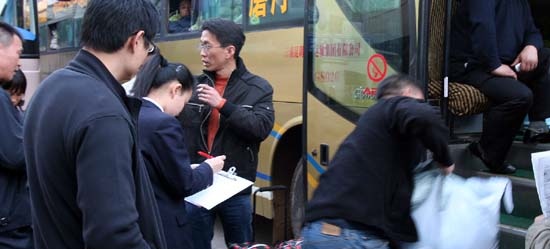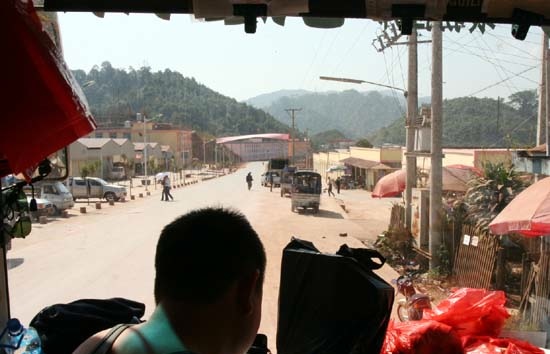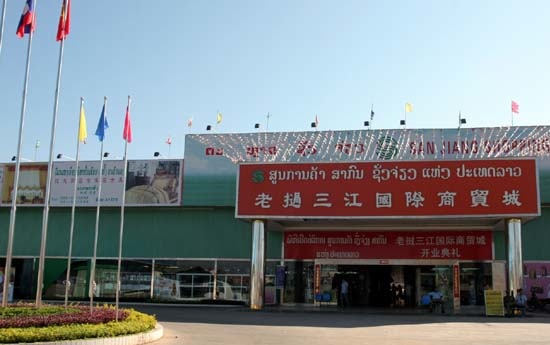China Gives Southeast Asia’s Poorest First Time Access to Consumer Goods

This is the fifth in a series of articles that looks at China’s borders. As China has grown in the last 30 years, so have the often complicated relationships it has with its many varied neighbors. In this article, we take a look at Laos.
By Andy Scott
VIENTIANE, Laos, Jan. 23 – The Lao call them Jin, and since the late 1800s when groups of marauding Chinese on horseback called Haw Jin first arrived, they have been coming into Laos in search of fortune.
Southeast Asia has long had Chinese immigrants, and from Thailand and Singapore to Indonesia and the Philippines, many of the region’s wealthiest and most powerful families trace their ancestry back to the mainland. Former Thai Prime Minster Thaksin Shinawatra and former Philippine President Corazon Aquino are just two example of this. While nationalism has hindered many of Chinese descent in countries like Malaysia and Indonesia from taking office, they long ago became the de facto merchants and bankers of the region.
Today, a new wave of Chinese immigrants is flooding south. Far from the rich and powerful families that preceded them, these Chinese come from the country’s interior, a location that has missed much of the economic transformation of China’s eastern coast. These cooks, laborers, merchants and tourists are leaving behind their economically depressed regions, often for destinations even poorer.
At the Kunming long-distance bus station, Chinese merchants and tourists crowd around a sleeper bus bound for Vientiane, the capital of Laos. The storage compartments under are already filled with boxes full of merchandise headed to the capital, and now passengers are fighting to load the last of their large sacks onto the bus, shoving bags under bunks and into the aisles.
Run by a Chinese family in Kunming and Luang Prabang, Laos, a private sleeper bus departs from Kunming every afternoon at 5 p.m. bound for the Laotian border and Vientiane. Inside, the bus is divided into three rows of bunk beds, accommodating 33 passengers for the 40 hour trip. Passengers spend most of the trip lying down, with badly dubbed Hong Kong action flicks to help pass the time. After all the passengers have settled into their bunks, several more crowd aboard the bus, taking up positions on blue plastic stools in the aisles.
The four-lane divided highway that stretches south out of Kunming comes to an abrupt end after about 10 hours, giving way to a winding road that snakes its way though the southern Yunnan region of Xishuangbanna. With a new highway still under construction and not available, buses and trucks making their way into Laos are still restricted to this older passage. Though, it remains to be seen just how effective this expanded road system will be as once across the border in Laos, vehicles remain restricted to a road that is barely big enough for two cars to pass each other.
Immigration and customs for the Lao People’s Democratic Republic is located in the border town of Boten. The post has seen increased traffic in the past three years and now provides a visa-on-arrival service for those who failed to get a visa at the consulate in Kunming. On this trip south most of the Chinese on the bus have already prepared their documentation and hand over 4,000 Kip (approximately 50 cents US$) to the immigration officials to fill out their entry cards for them.
Several passengers are heading to the former royal capital and UNESCO World Heritage Site, Luang Prabang. As Wang Xiaofang, a tourist from Henan province explains: “It’s not just the rich who like to go on vacation. I’m heading to Luang Prabang because Laos is cheap to travel to.”
Mr. Wang and his companions are sitting around a table at a small restaurant that hugs the road heading south. BeerLao is passed around and everyone seems to be in a good mood, pointing out the differences between Laos and China and happily chatting about what lies ahead in Luang Prabang and Vientiane. The group has been forced to wait just past customs as several of the passengers on the bus as well as the driver failed to accurately declare goods for import. Lao customs officials question the driver attempting to ascertain the worth of the items on the bus.
Goods flowing across the border from China to Laos are often transported in this way on private bus lines, and the relative size of the customs house in Boten reflects the Lao government’s problems with regulating imports and exports. Trucks bound for China are constantly pulling out of the Customs parking lot carrying Laos’ natural resources for the growing economic giant. On their way through the border, they pass trucks and buses heading south with cheap Chinese consumer goods, goods that a few years ago only the richest in Laos could afford.

A bus driver inspects immigration documents at the China-Laos border in Boten, Laos
As the bus finally pulls out of Boten – customs duties paid – more Chinese board, returning to Vientiane after a trip to the border to collect more goods to sell. “Life in Laos is very good,” says Chen Li, a Chinese migrant from Sichuan province who has set up a shop in Vientiane. “The Lao people are nice and it is easy to make money here.” What she doesn’t say is how her presence and that of the rest of the new class of Chinese merchants is changing the face of Laos.
In August 2007, the newest and biggest shopping mall in Laos officially opened. Officially named the Sanjiang Shopping Mall, the new Chinese market, or Talat Jin as the Lao call it, covers 174,000 square meters with over 300 individual shop spaces. Of those, over 200 have been filled by Chinese merchants with the remaining 100 or so spaces being filled by Lao businesses.

The Sanjiang market in Vientiane, Laos
Built at a cost of US$6 million, the shopping mall is part of a larger US$18 million investment project by the Sanjiang Company, a Chinese investment firm. “The shopping mall reflects the relationship of cooperation and traditional solidarity between Laos and China,” said Jiang Dingguo, the president of the Sanjiang Company, at the opening ceremony for the new market.
The new market, Mr. Jiang commented, is now the “largest mall for Chinese products in Southeast Asia, and a gathering point for the city’s Chinese merchants.”
Unlike the older Morning Market which contains Lao handicrafts and Thai consumer products, nearly all of the goods sold at the Chinese market are imported from China. From cheap stereo electronics and appliances to home furnishings and pirated DVDs, most of the items at the market have been brought into China the same way Ms. Chen brought her two bags of goods, overland and through private means.
Whether it is cheap televisions, appliances, or the ubiquitous 100 cc. motorcycles that crowd the streets of Vientiane, Chinese goods are changing the face of Laos, allowing many families to buy for the first time products they could only dream of a few years ago. The questions of quality that have plagued Chinese imports in the West are a distant concern here in one of the poorest corners of Asia. “Of course Chinese goods are not as well built as Japanese or Thai products,” says a tuk-tuk driver in Vientiane who doesn’t offer his name, “but they are cheap and many people can now afford to buy them.”
This is the fifth in a continuing series that focuses on China’s borders. The complete series to date can be found here.
- Previous Article China looks to Southeast Asia, but roads continue to hinder development
- Next Article New railways to further link Xinjiang to Central Asia










